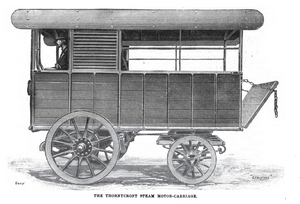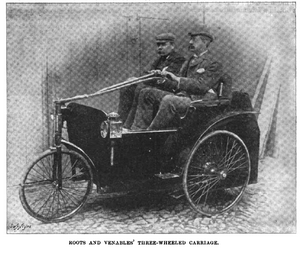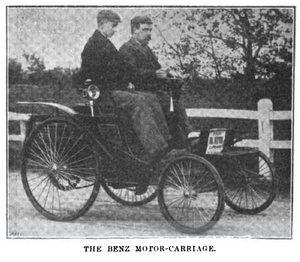|
By accessing or using The Crittenden Automotive Library™/CarsAndRacingStuff.com, you signify your agreement with the Terms of Use on our Legal Information page. Our Privacy Policy is also available there. |

Types of Horseless Vehicles
|
|---|
|
|
Types of Horseless Vehicles
The Automotor and Horseless Vehicle Journal
November 17, 1896
 The Thornycroft Steam Motor-Carriage. The Thornycroft Steam Motor-Carriage.
 Roots and Venables' Three Wheeled Carriage. Roots and Venables' Three Wheeled Carriage.
 The Benz Motor-Carriage. The Benz Motor-Carriage.
|
The Thornycroft Steam Motor-Carriage.
Mr. Thornycroft, whose name is identified throughout the world with high-class torpedo-boat machinery, has identified himself with the new self-propelled traffic, and designed a steam-carriage which will carry a load of one ton, and weighs about 35 cwt. when in full working order—including the weight of the coke used as fuel, the driver, and water necessary for a run of 20 miles.
The boiler is of the Thornycroft water-tube launch type with water fire-bars, steam being raised in about 15 minutes. The engine is double compound, the cylinders being respectively of 2 and 4 inches diameter, with a stroke of 3 inches. The engine speed is geared in the ratio of 9 to 1 to the road driving wheels. The condenser is placed in the roof, and is of sufficient cooling surface to condense all the steam at ordinary rates of working.
The van can climb an incline of 1 in 10 when fully loaded. The ordinary speed of working is about six or seven miles an hour, but a speed of nine miles per hour can easily be sustained on level roads. The floor space available for carrying goods is about 25 square feet.
Several trials have been made of this carriage with excellent results, while the name of Thornycroft is sufficient guarantee of the admirable quality of the workmanship and material which is used throughout. For developing this new branch of work an establishment has been founded under the title of the Steam Carriage and Wagon Company, Homefield, Chiswick Mall.
An American Motor Carriage.
From our representative in the United States we learn that a carriage capable of attaining a speed from three to 18 miles an hour has been invented by a Springfield man, and an extensive factory will be erected for the manufacture of the vehicle. The promoter of the new carriage is Henry W. Clapp, and the inventor is Charles E. Duryea, both of Springfield, Ohio. A company is now being formed, and nearly one-half of the required capital of £60,000 has been secured. The new carriage has been given repeated tests, all of which have been successful. A trip was made to Hartford and return recently, inside of three hours. In appearance the machine resembles an ordinary side-bar four-wheel carriage. The wheels are rubber-tyred and run on ball bearings. Each of the front wheels instead of turning on a central bolt, as is the case with ordinary carriages, revolves on its own pivot located in the hub, thereby making each turn in a much smaller radius, and, consequently, being easier to operate in steering. The vehicle is easily manipulated by a lever located in front of the driver. A lateral motion of the lever turns the wheel while the vertical motion controls the speed. One of the advantages of the carriage is that by pressing a button connected with a brake drum the vehicle can be stopped almost instantly, thus lessening the danger of travelling in the streets. The motor is compactly located under the seat, and is stated to weigh about 1 cwt. for an output of four horse-power. Near this is a dynamo. To start the wagon a crank is revolved once on the side of the wagon. This turns the motor which starts the dynamo, which generates the necessary sparks to explode the oil-gas contained in the combustion end of the cylinder. Since the experimental machine has been completed it has been run over 1,000 miles, and is reported to have established its practicability on country as well as city roads.
Roots and Venables' Three-wheeled Carriage.
This vehicle, which we illustrate as manufactured by Messrs. Roots and Venables, of 100, Westminster Bridge Road, is built with a strong angle steel frame, carrying the oil motor of 2½ horse-power at the back, together with the exhaust box and small water-tank. The power is transmitted from the crank-shaft of the engine to a counter-shaft by means of belts working on various-sized pulleys, which counter-shaft again transmits the power to the axle of the carriage by a pinion and toothed wheel.
This two-speed gear runs the carriage at ten or four miles an hour as desired. In front of the carriage the larger water-tank is fixed out of sight beneath the feet of the riders. The carriage steers remarkably easy, and is fitted with two brakes, one on the front wheel and the other on a drum on the main axle. Sufficient oil is carried for a run of 27 miles in the tank, but more can be easily placed under the seat.
The tyres are of solid indiarubber dovetailed into steel rims.
The oil used is common American Tea Rose or Royal Daylight, price 5½
d. per gallon.
The specific gravity of this oil is from 8 upwards. Consequently it is quite safe to use, and must be distinguished from the gasoline or benzoline used by most other carriages, particularly those at present running in France.
The Benz Motor-Carriage.
A Bradford correspondent writing of this vehicle—which is the invention of Mr. Benz, of Mannheim, and is being introduced into this country by the Arnold Motor-Car Company, of East Peckham—gives an interesting account of a ride which he recently enjoyed. He states that, "by the courtesy of the local agent, Mr. James E. Tuke, Aldermanbury, he was initiated into the mysteries of the horseless carriage, riding with Mr. Tuke in a small car of 1½ horse-power from Otley to Bradford, the time occupied being an hour and twenty minutes exactly. The day was very unsuitable owing to the heavy condition of the roads, and the success of the ride under such adverse circumstances showed how great the scope of the invention must be. At present the machine is hardly out of the experimental stage; but on the flat a good speed was attained. One fine feature of the machine is the ease with which the speed is regulated, without having recourse to the brake. Holdings Hill can be descended, either fast or slow, by simply setting the indicator, or, if economy be aimed at, the gearing may be shifted, and the wheels allowed to revolve down hill under control of the brake. It appears that a car of 1½ horse-power is not quite equal to carrying two people up the Yorkshire hills in bad weather, but an addition of "½ horse-power" would probably be ample. The little carriage now in Mr. Tuke's possession is one of the smallest made, and its value is about £130. No particular mechanical knowledge is required to understand the working of the car, and when once charged with oil and electricity it will run for 150 miles. The sensation of travelling by this new and convenient method is precisely that of cycling, with the exception of the labour involved by the latter. All that is needed for motor-car riding is a hand for steering and a head to restrain one's natural inclination for racing on the public road. Of the utility and general merit of the horseless carriage there cannot be any doubt. For doctors the novelty appears to offer immediate advantages, but a general adoption of the vehicle by tradespeople and others will naturally be a work of time, and must depend upon the further development of the invention itself." These motors have found much favour in France and Germany, and will doubtless obtain a fair measure of success in this country.

















 The Thornycroft Steam Motor-Carriage.
The Thornycroft Steam Motor-Carriage.
 Roots and Venables' Three Wheeled Carriage.
Roots and Venables' Three Wheeled Carriage.
 The Benz Motor-Carriage.
The Benz Motor-Carriage.
